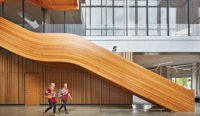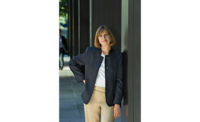There are few countries whose modern identity is more closely linked to a rich culture of design and architecture than Finland. Its great exponent, of course, was Alvar Aalto (1898–1976), whose career exemplified the notion of Gesamtkunstwerk—or total work of art—meaning that his hand touched everything from master plans to glassware. Eliel Saarinen, half a generation his senior, held a similar position. Recalled Eero Saarinen, “My father used to say that, from an ashtray to a city plan, everything is architecture.”
Last month, I went to Finland for the 13th International Alvar Aalto Symposium, held every three years. Though Aalto died nearly 40 years ago, his influence, and that of other early Finnish modernists, can still be seen in Finland’s contemporary planning, architecture, and design. The appreciation of design seems embedded in the country’s DNA. Touring an exemplary new public elementary and middle school, designed by Verstas Architects for a Helsinki suburb, I saw well-appointed workshops where all children learn crafts such as weaving and woodworking, as part of the national, gender-neutral curriculum.
Today, work by contemporary Finnish architects still draws international attention—for example, the award-winning Museum of the History of Polish Jews in Warsaw, by Lahdelma & Mahlamäki Architects and a notable addition to an Aalto library in Seinäjoki by JKMM. But many more fine architects, not well-known outside Finland, are contributing to the country’s extensive program of public architecture, commissions often won through open competitions. They are designing not only schools but libraries, daycare centers, churches (which function as community centers), and multifamily housing, such as an innovative project by the firm OOPEAA in the city of Jyväskylä, a wood structure with modular components.
In Helsinki, government-planned developments are sprouting along the waterfront. In a former industrial port on a peninsula jutting into the harbor, the design and construction of a new neighborhood for 17,000 people is under way. Already, 3,000 residents have moved into the area, which will offer a variety of dwelling types, from upscale townhouses near the shore to middle-class apartments for sale at affordable prices, to low-cost rentals. (Among the amenities are a vacuum waste-collection system that whisks away garbage underground, making smelly dumpsters and rumbling sanitation trucks obsolete.) One model development of cohousing is now occupied by “students, pensioners, and aging rock musicians,” says Helsinki’s new deputy mayor for planning, Anni Sinnemäki. As she describes it, the city’s general plan encourages greater density, access to public transportation and bike paths—55 percent of Helsinki’s households do not own cars—and introduces “boulevardization” to five motorways that cut into the urban realm.
But it is for Aalto’s buildings and his legacy that most global architects flock to Finland. That was clearly a big lure for the international designers who joined the Aalto Symposium this year. Despite the focus on making architecture—the theme of the symposium was “Do!”—what emerged most strongly in the presentations was the power of social impact. From Rahul Mehrotra’s design for a community toilet for the informal settlements of Mumbai (where there is one latrine per 1,000 people) to Raul Pantaleo’s projects—with his Italian firm TAMassociati—for sheltering refugees, to Carin Smuts’s community cultural centers in South African townships to Liu Xiaodu and his firm URBANUS’s schemes to improve housing for the exploding population of Shenzhen, it was impossible to appreciate and discuss materials, structure, digital technology or architectural aesthetics separately from the vast numbers of people that good architecture could and should serve. “Design with a divided mind,” is how Mehrotra described the reality for architects working globally today.
Finland, with its vast countryside of picturesque lakes, immense forests of birch and fir trees, has only 5.4 million people. Yes, it has economic struggles—unemployment stands at nearly 10 percent—but it doesn’t face the complexity of problems of much larger nations. Yet while the design culture may seem steeped in the romance of Aalto and the fetishization of the object—the perfect chair! the elegantly crafted textile!—the country provides an impressive lesson, as well, in the power of good architecture brought to a wide public realm.







Post a comment to this article
Report Abusive Comment